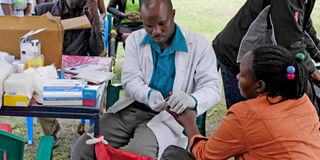How Rwenzori registered gains in fight against HIV

Impact. A health worker takes a blood sample from a woman during an HIV/Aids testing camp at Buhinga playgrounds in Fort Portal Municipality, Kabarole District, in April. PHOTO BY ALEX ASHABA
What you need to know:
- According to WHO, the prevalence of HIV among adults aged between15 and 64 in Uganda is 6.2 per cent with 7.6 per cent among females and 4.7 per cent among males.
- This corresponds to about 1.2 million people aged 15 to 64 living with HIV in Uganda.
Kabarole. Health authorities in Rwenzori have registered successes in the last three years in the fight against HIV/Aids that has been a challenge in the sub region, a survey has shown.
The sub-region comprises Kabarole, Kamwenge, Kyegegwa, Ntoroko, Bundibugyo, Bunyangabu, Kasese and Kyenjojo districts.
A survey conducted by the Uganda Population-Based HIV Impact Assessment (UPHIA) between August 2016 and March 2017 indicates that HIV/Aids prevalence has reduced from 8.3 per cent in 2015 to 5.7 per cent in 2017 in the sub-region.
According to the report, HIV prevalence is higher among women living in urban areas (9.8 per cent) than those in rural areas (6.7 per cent). The HIV prevalence among children aged 0-14 is 0.5 per cent, which corresponds to the national rate of about 95,000 children living with the disease in Uganda.
The survey also shows that the viral load suppression among HIV-positive adults aged between15 and 64 is at 55.3 per cent in the sub-region for the same period.
Kabarole, which has had the highest HIV/Aids prevalence in the sub-region, has also seen a reduction, from 15 per cent to 10.3 per cent last year, according to the report.
The District Health Officer, Dr Richard Mugahi, attributes the success to embracing of the test-and-treat policy that was introduced by the Ministry of Health in 2016.
Dr Mugahi says currently, the district has 24,000 people living with HIV/Aids and 95 per cent of them have been enrolled on antiretroviral treatment (ART).
The test-and-treat policy recommends that an individual, once diagnosed with HIV/Aids, be enrolled immediately on ART regardless of the disease stage and CD-4 cell count.
Following the adoption of the policy last year, Kabarole identified 29,108 individuals on HIV care; 58.8 per cent female and 41.8 per cent male. Of these, 26,943 were enrolled on ART and 89 per cent are retained, which was an increase.
Dr Mugahi also attributes the success to minimising the transmission of HIV/Aids from mothers to new born babies. In 2015, the mother-to-child transmission rate stood at 5 per cent but it fell to 1.6 per cent last year, according to the survey.
“When pregnant mothers come for the first antenatal visit, it is compulsory in all health facilities that offer these services to test them for HIV/Aids and if we find them positive, we enrol them on drugs and also encourage them to deliver from hospitals,” Dr Mugahi says.
He says the district also introduced a new method of testing targeted groups as opposed to mass testing.
“We now use targeted testing where we have identified some groups such as boda boda riders, tea estate workers and long distance truck drivers. We move to their places and have them tested, which has helped us to get new people enrolled on ARVs,” Dr Mugahi explains.
Role of VHTs
The district HIV/Aids focal person, Ms Catherine Kemigabo, also thanks development partners such as Baylor Uganda that have programmes of fighting HIV/Aids.
“We have been using village health teams to educate communities and helping us to know discordant couples to be tested,” Ms Kemigabo says.
The in-charge at Bukuku Health Centre IV in Kabarole District, Dr Solomon Asiimwe, says the introduction of fingerprint technology at the health facility has greatly helped to trace HIV/Aids patients.
He said previously, there was duplication of records where patients could do double testing in different health facilities but the new technology is able to capture everyone who has been tested.
The Bunyangabu District Health Officer, Dr Richard Obeti, says the introduction of the 90-90-90 UNaids strategy has helped in the reduction of HIV/Aids prevalence in the area.
The Ntoroko District Health Officer, Dr Rodgers Mugisha, says the district introduced the service delivery model where patients form their groups in communities on how to receive drugs and take them in order to have their viral load suppressed.




